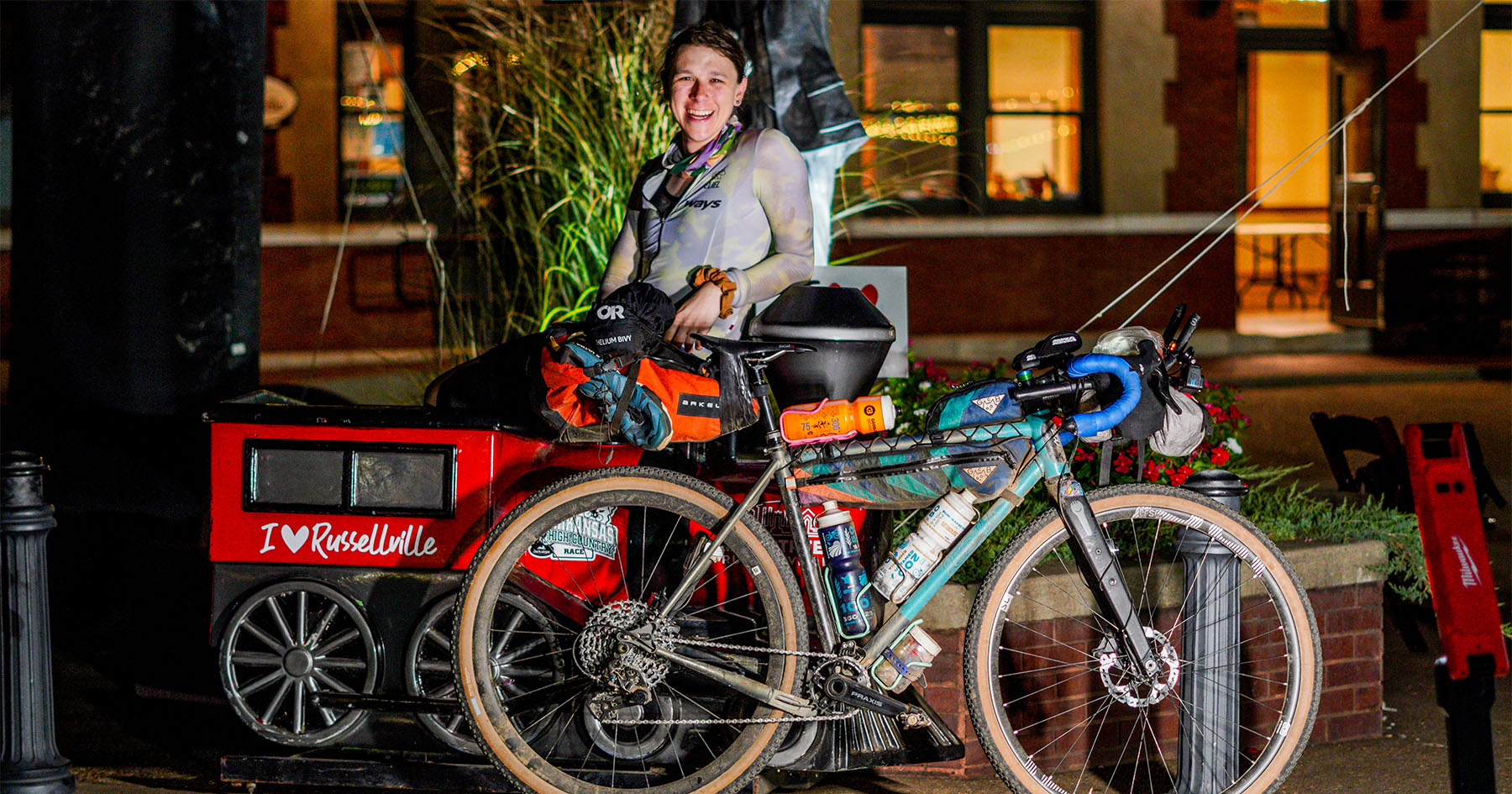PROTECT YOUR DNA WITH QUANTUM TECHNOLOGY
Orgo-Life the new way to the future Advertising by AdpathwayExperience the beautiful landscapes of the Vaucluse region with its famous villages, challenging gravel climbing, and cheerful living in the heart of Provence. You’ll see limestone crags, forests, lavender fields, olive trees, and vineyards while being watched by bee-eaters, red kites, and the Giant of Provence, Mont Ventoux. You’ll even have the option to climb to the iconic barren white summit and experience the adventurous way back down in an area of France that is less known for off-road bikepacking...
Photos by Bert Vinken, Laurence Aubry, Jan Hindriks, and Kasper Zinsmeister
The Vaucluse is a region in the foothills of the Alps, with Mont Ventoux as its highest point, and it encompasses the most beautiful aspects of Provence. Officially Département 84, it is an area with a long history, with sites dating back to the Roman Empire. You can see remnants of Roman influence throughout the region, such as the Via Domitia, which runs through the Calavon valley, and the Pont Julien, which the route crosses.
In late spring, the lavender starts to bloom, and you will see many olive trees and grapes along the way. It is an area with little rainfall and lots of sun. Fruit cultivation is mainly possible on the west side, where there is sufficient water from the Sorgue, Rhone, and Durance rivers. The Sorgue rises in Fontaine de Vaucluse, the largest karst spring in France and one of the largest springs in the world. Fontaine de Vaucluse is one of the typical French villages that the route visits. It’s lively, touristy, and equipped with plenty of bakeries and joie de vivre. These provide a welcome change after some strenuous hike-a-bike sections in the forest and riding on the slopes of the Dentelles de Montmirail, the Monts de Vaucluse, the Luberon, and the Mont Ventoux.
Another site that certainly deserves attention is Buoux. In the 1980s, Buoux was the place to be for the best European rock climbers. Despite being almost forgotten, it is still a special valley, so make sure to follow the route on a dead-end road with an inn at the foot of the cliffs. Stay a while and enjoy the serenity. Un espresso, s’il vous plaît.
One of the Luberon’s treasures is its ancient ochre quarries, where the extraction of this pigment began in the 18th century. Ochre is a pigment that ranges in colour from soft yellow to intense brownish red. And this is clearly visible in the landscape. Today, there is still one active quarry, and several other quarries are open to visitors in Roussillon and Rustrel. Be sure to look to your right in Roussillon, where you can enjoy a beautiful view of the ochre cliffs. Or take the time to stroll through the old quarry on site.
Beyond the villages and human history, the route takes you through a rugged karst landscape with scrub pine and oak forests and along many iconic rock formations. Mont Ventoux towers above the landscape almost every day. The route mostly uses wide gravel roads and quiet country lanes, but sometimes riders may want to walk up (or down) a steep, rocky section of singletrack. There are some substantial climbs that can be very long or steep (or both).
The highlight of the trip is the climb up the northern slopes of the Mont Ventoux from Montbrun les Bains. Up to an altitude of 1,500 meters, you are unlikely to encounter other cyclists as you stick to unpaved roads. You’ll climb the last 400 meters on the Malaucène side along the asphalt road. At the summit of the Giant of Provence, you may have a view of the Rhone Valley, the Alps, and, in the distance, the Mediterranean Sea. But be aware that the weather can change frequently on the summit. In sunny weather and with little wind, Ventoux may feel like a fairly easy climb. In rain and storms, it proves to be an almost impossible climb, being exposed to all sides.
Route Development
In 2022, I moved from the Netherlands to Luberon. One of the reasons for this was the area itself, with all the cycling opportunities it offers and, of course, the presence of Mont Ventoux. At first, I explored mountain bike routes. These are often very technical and too difficult for a bikepacking trip. After mapping it out in Routeyou, I explored this route in stages over several weekends and overnight stays, with some trial and error. In 2024, I cycled the entire trip with a group of six people in six days. In 2025, I did it again with a group in seven days. For some, the original route proved too difficult, but there are regular shortcuts or paved detours along the way.
Route Difficulty
The route consists mainly of wide gravel roads and quiet country lanes. There are short sections of singletrack and steep, rocky climbs or descents that riders may want to walk. Some climbs are quite long, and some are quite steep. Water is often not available along the way, so it is recommended to carry at least two liters of water. It is easy to visit a shop every day, but be aware of local closing times.
Submit Route Alert
As the leading creator and publisher of bikepacking routes, BIKEPACKING.com endeavors to maintain, improve, and advocate for our growing network of bikepacking routes all over the world. As such, our editorial team, route creators, and Route Stewards serve as mediators for route improvements and opportunities for connectivity, conservation, and community growth around these routes. To facilitate these efforts, we rely on our Bikepacking Collective and the greater bikepacking community to call attention to critical issues and opportunities that are discovered while riding these routes. If you have a vital issue or opportunity regarding this route that pertains to one of the subjects below, please let us know:
- The climb (and descent) of Mont Ventoux (nicknamed “the bald mountain”), endless climbing and descending on good gravel.
- Dentelles de Montmirail: unique rock formations, mountain villages and vineyards.
- Fontaine de Vaucluse: the source of the Sorgue River and surrounded by impressive rock faces.
- Petit Luberon, with its rugged, rocky southern slopes and cedar forest.
- Grand Luberon with sweeping views and a route over the ridge.
- All the mountain villages along the route, France at its most beautiful.
- Wildlife: with the best chance of seeing birds such as bee-eaters, vultures, short-toed eagles, and, with a lot of luck, golden orioles. But also lizards, adders, hares, foxes, and wolves.
- Natural wine from the Luberon (unfiltered, unprocessed wines).
- Ochre quarries; red, yellow, green and orange rock formations; and, hopefully, bee-eaters.
- The track at Montjustin with layered rock bottom and the singletrack just before Buoux.
- Buoux: feel the climber’s vibe and spot “Le Bombe Bleu,” a rock climbing route that still hasn’t been climbed after 35 years!
- Cucuron with a basin on the village square and a natural swimming pool at the campsite.
- Artisanal ice cream in Lourmarin, Beaumes-de-Venise and Bonnieux, among other places.
When to go
- The route is best ridden after the road on Mont Ventoux has opened, usually from the beginning of May. May-June and September-October are the best months; in summer, it is often too hot.
- During the summer months, there are restrictions on access to forests in the region. Check for restrictions here.
Logistics
- Travel Basics: If you are travelling by train, Orange, Carpentras, and Cavaillon are stations located a short distance from the route. Avignon is also an option. There is a bus connection to Apt that (occasionally) transports bicycles. Note that some SNCF trains require bike reservations, and many high-speed TGV trains, especially to Avignon, require bikes to be in a bike box or bag and checked as luggage. Confirm the details for all SNCF trains here.
- Access & Parking: The most obvious starting point is Malaucène or Beaumes-de-Venise, because the first few days are relatively easy and the toughest climb is at the end. Beaumes-de-Venise in particular is easily accessible from the Carpentras train station via a 10km, relatively easy ride with half the distance being on a bike path. Asking if you can leave your car at a campsite is usually met with a positive response, especially outside the summer months. Many of the sites have one or more bicycle repair shops.
- Bike: Although the route is largely suitable for a gravel bike with 40 mm tyres, a mountain bike with front suspension and wider tires (2.2″) is still recommended. Consider a low, easy gear ratio for the long climbs, and remember there are long descents as well.
- Packing & Gear: Water-carrying capacity of at least 2 liters is important for longer stretches without resupply. Water sources are not frequent outside of resupply locations.
- Although Mont Ventoux is not particularly high compared to the giants of the Alps, it is still alpine terrain. Mont Ventoux is known for being very windy, but that is not always the case. Be prepared for cold and stormy conditions around the summit, even if the weather in the valley is fine! Check the weather forecast for the chance of storms.
- At the start of the climb to Mont Ventoux, there is a beautiful stretch of road, but the track runs a few metres to the right of it. The road is private property, and you will have to walk through the bushes for about 200 metres.
- After Fontaine de Vaucluse, follow the Carpentras canal for a short distance. The path is partly narrow, so be careful not to fall into the water. If in doubt, dismount!
- Almost every day, there will be a short hike-a-bike section. Get off your bike in time!
- After rain showers, some parts can become difficult to pass with very sticky clay!
- Sheep flocks are always accompanied by a few Pyrenean Mountain dogs to scare off wolves. When passing a flock, get off your bike and walk quietly past.
- Mosquitoes can be a nuisance, so bring a good mosquito repellent.
- Some campsites open very late (May) or close very early (September).
- The sun is strong in this region, so remember to bring good sunscreen.
What Bike and Gear
Dangers & Annoyances
- Wild camping is not officially permitted.
- In addition, this is a region where forest fires can easily occur. Both Ventoux and Luberon are regional nature parks with corresponding regulations.
- Outside the winter months, and especially when campsites are open, it is preferable to camp at private campsites or arrange a bed in a gîte d’étappe (group cottage).
- The region has more than enough campsites and accommodation options.
- Every day, there are multiple opportunities to shop and gather resupply.
- Please note that some sections (Mont Ventoux, Monts de Vaucluse, Petit and Grand Luberon) have long stretches of up to four to five hours without any facilities.
- French bakeries are famous for their sweet pastries, and this region is no exception. There are also several artisan ice cream makers along the route.
- Tap water is always drinkable, unless it is explicitly marked “non potable.”
- Smaller shops often have extended afternoon closing times. From 12:00 to 15:00 is often “siesta” time. The Garmin map is not always accurate in this regard!
To maintain a degree of adventure on the ride, there is no day-to-day itinerary. However, here are a few comments in case the route proves to be too difficult.
- On Ventoux, there are a few forks in the route, and you can always choose to descend via the asphalt road from Mont Serein.
- The Petite Luberon offers the (easier) option of climbing straight up at the transmission tower instead of descending to the right. Stay on the “asphalt” and pick up the route again at Lourmarin. You will be further on down a somehow busy road.
- After the Grand Luberon (climb and partial descent), there is an option to take the short road to Sereste, which saves you a considerable amount of gravel and rocks.
Terms of Use: As with each bikepacking route guide published on BIKEPACKING.com, should you choose to cycle this route, do so at your own risk. Prior to setting out check current local weather, conditions, and land/road closures. While riding, obey all public and private land use restrictions and rules, carry proper safety and navigational equipment, and of course, follow the #leavenotrace guidelines. The information found herein is simply a planning resource to be used as a point of inspiration in conjunction with your own due-diligence. In spite of the fact that this route, associated GPS track (GPX and maps), and all route guidelines were prepared under diligent research by the specified contributor and/or contributors, the accuracy of such and judgement of the author is not guaranteed. BIKEPACKING.com LLC, its partners, associates, and contributors are in no way liable for personal injury, damage to personal property, or any other such situation that might happen to individual riders cycling or following this route.
Further Riding and Reading
Here are some connected/nearby routes and related reports...
Please keep the conversation civil, constructive, and inclusive, or your comment will be removed.


















 English (US) ·
English (US) ·  French (CA) ·
French (CA) ·